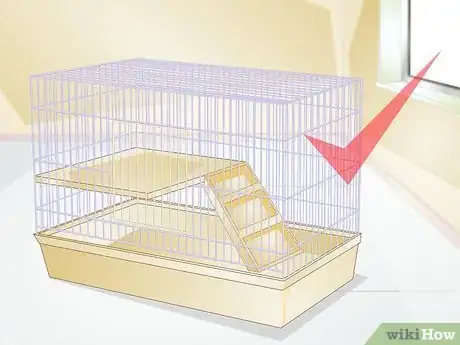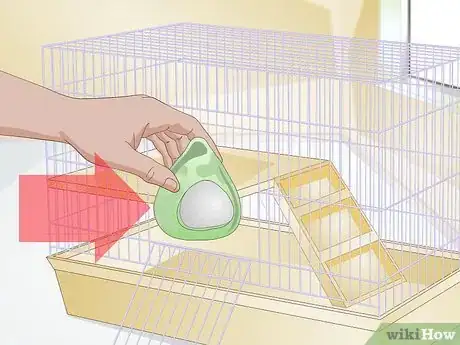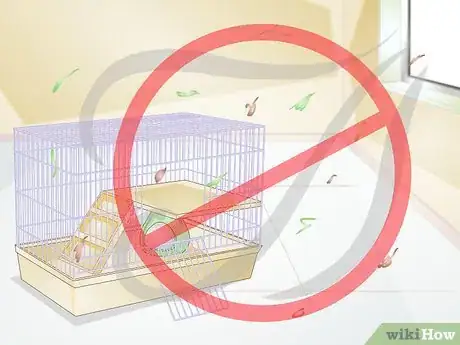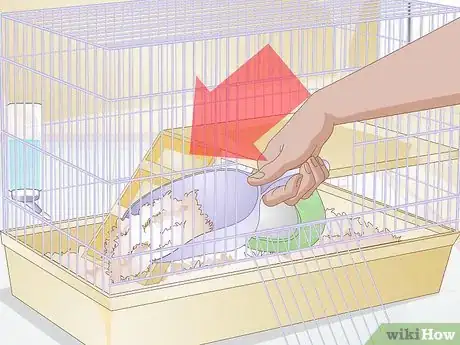This article was co-authored by Pippa Elliott, MRCVS. Dr. Elliott, BVMS, MRCVS is a veterinarian with over 30 years of experience in veterinary surgery and companion animal practice. She graduated from the University of Glasgow in 1987 with a degree in veterinary medicine and surgery. She has worked at the same animal clinic in her hometown for over 20 years.
This article has been viewed 45,485 times.
If you are preparing to bring home a pet hamster for the first time, you may be feeling excited and overwhelmed. Hamsters have special care and habitat needs that require some planning on your part. With a little effort, though, you'll be able to create a healthy and supportive home for your new pet.
Steps
Creating a Suitable Environment
-
1Choose the right cage. The first thing you'll need for your hamster is a cage. However, you should give some consideration to the type of cage you choose as this will be the primary habitat for your new pet. Some cages are better than others, and certain cage designs may be downright unsafe for hamsters.
- Wire siding allows hamsters to climb up the walls, which can help satisfy their curiosity and burn off some energy.
- Consider getting a multi-level cage. That way your hamster can have more room to explore and play.
- If there are any gaps in the bars, your hamster could get stuck.
- A cage with a deep plastic base will allow your hamster to burrow and roam. Aim for a large cage with a base that's at least 1 to 2 inches (3 to 5 centimeters) deep.
- Make sure there are no hazards, like sharp edges or bits of metal that might poke your hamster.
- Whatever cage you choose, it must be at least 360 square inches or 80x50 centimeters.
-
2Give your hamster a shelter/nesting box. Your hamster will need a small shelter or nesting box within its cage. This structure is to allow your pet a place to hide when it wants to sleep or anytime it feels frightened.
- The shelter or nesting box should be big enough for your hamster to move around inside with relative ease.
- Your hamster should also have enough room to store some food inside the shelter.
- Make sure the shelter is dark inside. Your hamster should be able to retreat inside and feel safe and protected.
-
3Control the climate. In the wild, hamsters live in warm, dry climates, so they'll need a similar atmosphere in your home. Try to create as conducive a habitat as possible that will allow your hamster to be comfortable and safe.[1]
- Make sure the room where you keep your hamster is free from drafts. Keep the cage away from any open windows or air conditioning vents.
- Make sure the environment is as dry and free from humidity as possible.
-
4Limit light exposure. Hamsters are sensitive to bright lights, but they can't live in total darkness. The idea for a hamster would be to have limited exposure to ambient light during the day and total darkness at night.[2]
- Avoid putting the cage in direct sunlight, though ambient sunlight in the room is okay.
- Try to keep the lights in your home on a regular schedule so that your hamster can be in the dark around the same time every night. This will help your hamster stay on a regular schedule.
Meeting a Hamster's Needs
-
1Get the right kind of food. Hamsters need a complete, balanced diet in order to remain healthy and active. They typically need a somewhat broad variety of foods, including seeds, fruits, and vegetables. Some hamster owners also give their pets occasional forms of protein like insects to supplement their diet.
- If using pellet food, choose a product with 18 to 22 percent protein content. You should be able to find this information on the packaging.
- Some hamsters prefer seed mixes instead of pellets. If using a seed mix, make sure the mix contains a variety of other foods like dried fruits/vegetables and a limited quantity of sunflower seeds.
-
2Provide fresh water. In addition to food, your hamster will need a steady supply of fresh, cool drinking water. You can use a water dish, but this is likely to spill. A water bottle is ideal for most hamster cages, but make sure you get the right kind for a hamster.
- Choose a water bottle with a sipper tube that does not have a valve. Hamsters cannot create suction very well, and consequently, they may struggle with a ball-valve bottle design.
-
3Give your hamster proper bedding. Hamsters need a comfortable substrate in their cages. The bedding material you choose should be clean, absorbent, and safe for hamsters. Avoid any materials that produce a lot of dust.
- Good bedding material choices include hardwood shavings, aspen shavings, corncob litter, or shredded white paper or facial tissues.
- Make sure your hamster's bedding is deep enough that it can dig and burrow through it. Aim for a depth of at least two inches of bedding spread uniformly across the cage.
-
4Get your hamster plenty of toys. Hamsters tend to cycle between periods of inactivity and periods of high energy. They'll need toys that allow them to exercise and explore, as well as chewable objects to help keep their teeth trimmed.
- A hamster wheel with a solid floor and an exercise ball are both excellent choices for hamsters.
- Look for hamster toys that involve tunnels and/or tubes, as hamsters enjoy burrowing and exploring.
- Give your hamster things to chew on like blocks of untreated wood or fresh, pesticide-free tree branches.
Making an Easy Transition to Your Home
-
1Try to use the same accessories and food. If at all possible, try to use the same food and accessories that your hamster used in its previous home. This can make the transition a little smoother for your new pet, as it will still have familiar things in its environment.[3]
- Do not use the same food if it is not nutritious. Likewise, avoid using the same accessories if they are unsafe or otherwise not ideal for a hamster's environment.
-
2Keep the cage covered for the first day or two. One way to help ease the transition into your home is to cover the cage for the first one to two days. This allows the hamster to adjust to its new cage in a calm, relatively dark environment.[4]
- If you decide to cover the cage, choose a light cloth that breathes well. Something made of mesh or a loosely-knit cotton should work well.
- Do not keep the cage covered indefinitely. Your hamster should only need a day or two to adjust.
-
3Give your hamster time and space before handling. If your hamster is still adjusting to your home, it may not be ready to be handled. Some experts recommend waiting at least a few days before attempting to pet or handle your hamster. You may need to wait even longer before allowing other visitors to handle the hamster, as they're even less familiar to your new pet.[5]
Choosing a Hamster to Take Home
-
1Look for signs of illness or neglect. Before you take home any pet, you should check to see that it is healthy and in good care. Some hamsters (like any other pet) are raised in inhumane conditions that cause health problems and other issues.[6] Some warning signs to look for include:
- listless behavior
- tilted head
- poor balance
- scabs on the ears, face, or feet
- sneezing or a runny nose
- watery eyes
- diarrhea
-
2Learn about different hamster breeds. There are several different types of hamsters that are commercially available. Which breed you choose will depend on your needs and your desired personality traits.[7] Common hamster species include:
- Syrian hamsters - these hamsters are slightly larger than many other breeds, and they are smart enough to learn some simple tricks. They tend to be somewhat approachable and easy-going when it comes to handling and being played with.
- Campbells dwarf hamsters - this breed of hamster is quite fast and can easily slip away if you're not careful. They are rather friendly, especially when handled from an early age.
- Roborovski dwarf hamsters - these hamsters are very low maintenance and are very friendly. Of all the hamster breeds, Roborovski dwarf hamsters are the least-likely to bite.
-
3Make arrangements for a vet visit. Before you take home your new hamster, you should arrange for your pet to see a veterinarian. Many hamsters are raised in poor conditions before they're adopted, while even healthy hamsters are susceptible to infections and diseases.
- Hamsters are often prone to abscesses in their cheeks, which can quickly lead to infection.
- Any change in appearance or activity should prompt a visit to your vet.
- Schedule regular checkups to ensure that your hamster remains happy and healthy.
References
- ↑ http://www.rspca.org.uk/adviceandwelfare/pets/rodents/hamsters/environment
- ↑ http://www.rspca.org.uk/adviceandwelfare/pets/rodents/hamsters/environment
- ↑ http://www.humanesociety.org/animals/hamsters/tips/welcoming_new_hamster.html?credit=web_id139895439?referrer=http://www.humanesociety.org/animals/hamsters/tips/hamster_tips.html
- ↑ http://www.humanesociety.org/animals/hamsters/tips/welcoming_new_hamster.html?credit=web_id139895439?referrer=http://www.humanesociety.org/animals/hamsters/tips/hamster_tips.html
- ↑ http://www.humanesociety.org/animals/hamsters/tips/welcoming_new_hamster.html?credit=web_id139895439?referrer=http://www.humanesociety.org/animals/hamsters/tips/hamster_tips.html
- ↑ http://www.peta.org/living/companion-animals/caring-animal-companions/caring-gerbils-hamsters/
- ↑ http://northstarrescue.org/pet-care-information/general-care-articles/74-choosing-the-right-species
About this article
To prepare for a new pet hamster, start by getting a cage and lining the bottom of it with a thick layer of bedding for your hamster to dig and burrow in. Then, add a variety of toys to the cage, like tunnels, a hamster wheel, and chewable objects, to keep your new pet entertained. Next, attach a water bottle to the inside of the cage, and provide a food dish filled with pellets or seed mixes for your hamster to snack on. Finally, place your hamster's cage in a warm, dry area. For more tips from our Veterinary co-author, like how to introduce your hamster to its new home, read on!



































